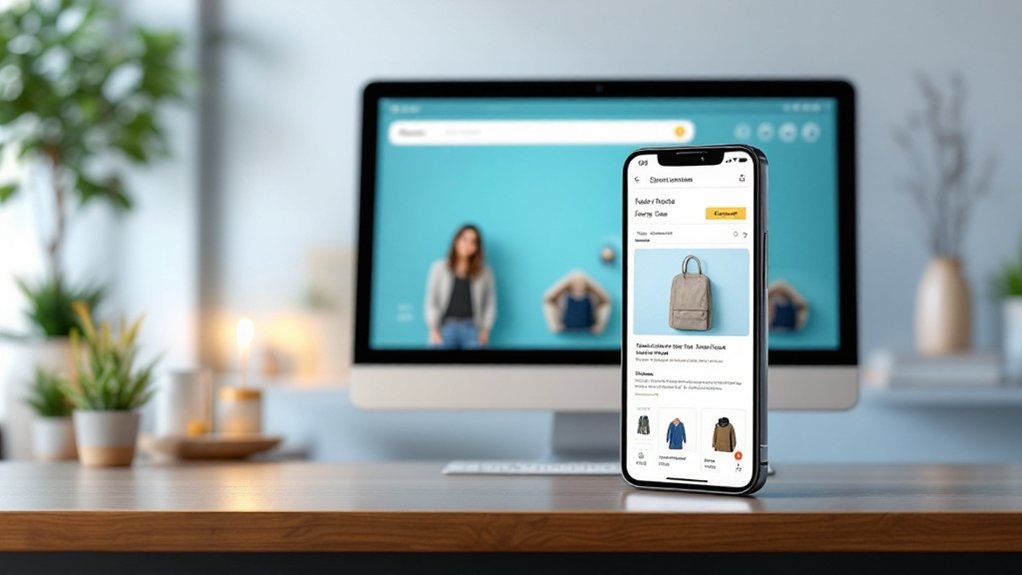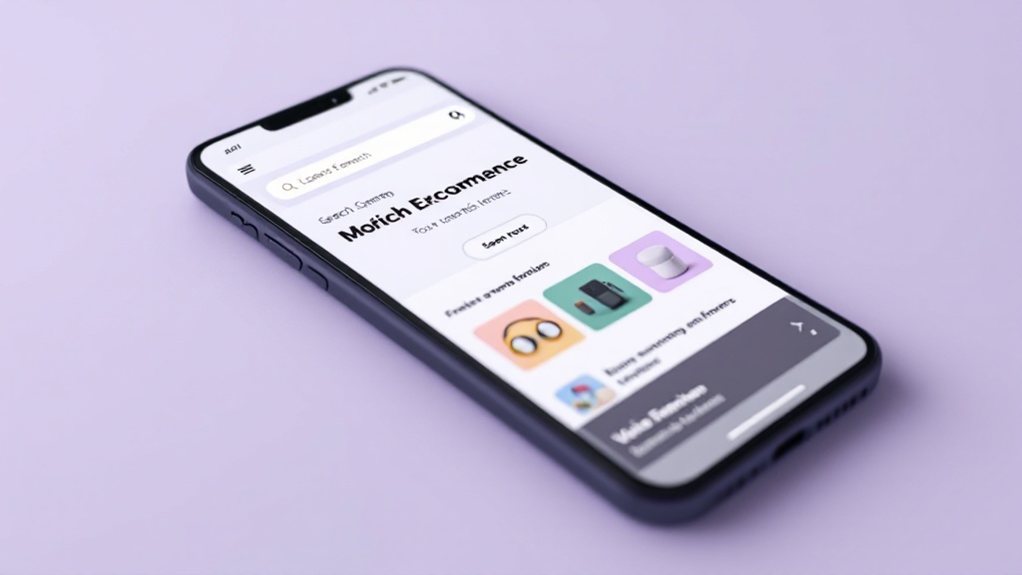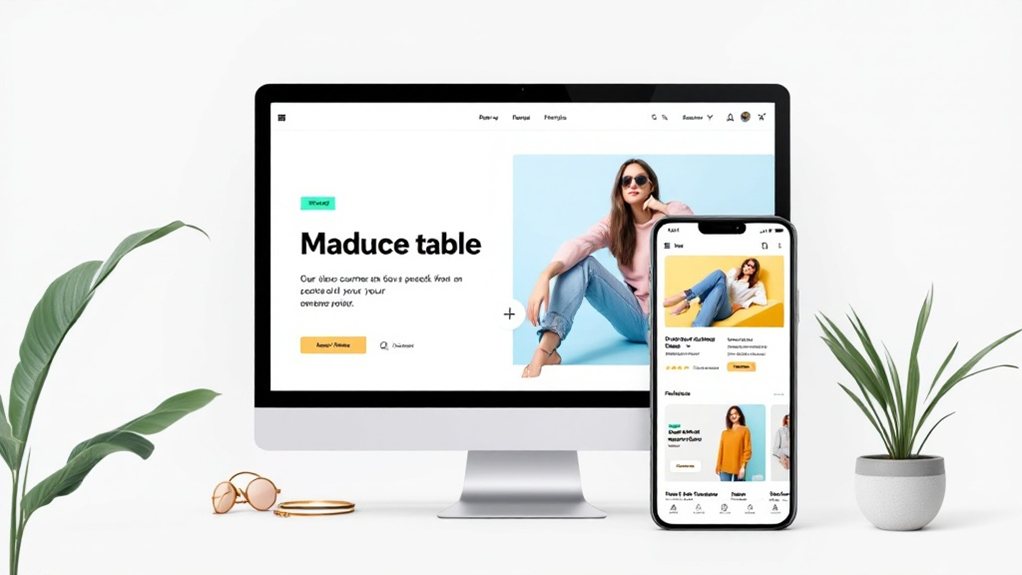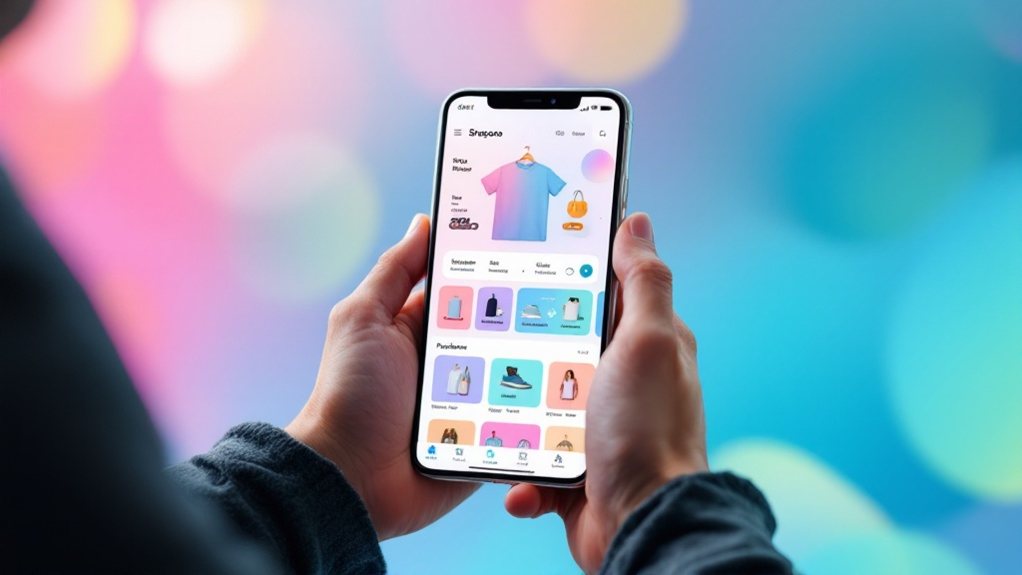To boost your e-commerce sales, optimize your site for mobile-first design. Streamline content, leverage responsive web design, and incorporate mobile-friendly features. Simplify the checkout process with autofill and one-click options. Use clean, readable typography that scales well across devices. Provide intuitive navigation and prioritize mobile-friendly imagery. Leverage AMP and secure mobile payments to further enhance the experience. Implement progressive web app technology to future-proof your e-commerce presence. Continuously monitor and optimize to drive higher engagement and sales. There's more you can do to elevate your mobile strategy.
Key Takeaways
- Optimize for mobile-first design by streamlining content, leveraging responsive web design, and enhancing page speed to meet mobile users' expectations.
- Streamline the checkout process by minimizing form fields, simplifying payment methods, and offering guest checkout to improve conversions.
- Implement responsive typography with a clean, readable typeface that scales well and maintains a clear visual hierarchy across devices.
- Incorporate intuitive navigation with a clear, prominent menu, sticky header, and internal linking for seamless user experience.
- Prioritize mobile-friendly imagery by using compressed file formats, responsive visuals, and content delivery networks to improve load times.
Optimize for Mobile-First Design

As the mobile landscape continues to evolve, optimizing for a mobile-first design has become increasingly crucial. Today's consumers expect seamless, intuitive experiences on their smartphones and tablets. By prioritizing the mobile user experience, you can ensure your e-commerce site is accessible, engaging, and conversion-driven. Start by streamlining your content, images, and navigation for smaller screens. Leverage responsive web design to ensure your layout and elements adapt fluidly. Optimize your page speed, as mobile users demand lightning-fast load times. Incorporate mobile-friendly features like tap-to-call and one-click checkout to enhance usability. Ultimately, a mobile-first approach will future-proof your e-commerce presence and drive higher engagement and sales.
Streamline the Checkout Process
With mobile-first design principles in place, you can now turn your attention to streamlining the checkout process. Optimize your checkout flow for mobile users by minimizing form fields, providing autofill options, and simplifying payment methods. Implement a progress indicator to give customers a clear understanding of where they are in the process. Offer guest checkout to eliminate the need for account creation. Use mobile-friendly payment gateways and avoid unnecessary redirects. Additionally, ensure your checkout page is visually appealing and mobile-responsive. By focusing on a seamless, frictionless checkout experience, you'll encourage more conversions and boost your e-commerce sales.
Leverage Responsive Typography

To optimize your mobile-friendly web design, leverage responsive typography. Responsive typography adjusts font sizes, line heights, and letter spacing based on the user's device and screen size. This ensures your content is legible and visually appealing on any screen. Choose a clean, readable typeface that scales well. Utilize flexible font units like REM or VW instead of fixed pixels. Adjust heading hierarchies and paragraph spacing to create clear visual hierarchy. Prioritize simplicity over complex typographic effects. Test your design across devices to ensure optimal readability and layout. Responsive typography enhances the user experience, boosts engagement, and drives higher conversions on mobile.
Incorporate Intuitive Navigation
How can you incorporate intuitive navigation into your mobile-friendly web design? It's crucial to make it easy for users to find what they're looking for. Start with a clear, prominent menu that's accessible from any page. Leverage sticky navigation that stays visible as users scroll. Optimize internal linking, so customers can seamlessly navigate between pages. Utilize clear, scannable section headings. Provide search functionality, allowing users to quickly locate products or information. Ensure consistency across your site, so the experience feels intuitive. By prioritizing navigation, you'll enhance the user experience and encourage more conversions on your mobile-optimized website.
Prioritize Mobile-Friendly Imagery

Effective mobile-friendly web design prioritizes imagery that performs well on smaller screens. Optimize your images to load quickly and display clearly on mobile devices. Use compressed file formats like JPEG or WebP to reduce image size without sacrificing quality. Ensure your visuals are responsive, scaling seamlessly across different screen sizes. Leverage content delivery networks (CDNs) to improve load times. Avoid using large, high-resolution images that can slow down your site. Instead, serve appropriately sized assets that enhance the mobile user experience. Prioritize visual elements that showcase your products or services in an engaging way. Optimized mobile-friendly imagery can captivate users and drive conversions on your e-commerce website.
Ensure Speedy Page Load Times
Speedy page load times are crucial for captivating mobile users. They expect your e-commerce site to load swiftly, or they'll bounce. Optimize images, videos, and other media by compressing files and serving scaled-down versions. Leverage browser caching to reduce subsequent load times. Employ a content delivery network to distribute your assets globally. Minify your HTML, CSS, and JavaScript to cut file sizes. Avoid heavy plugins and scripts that bog down performance. Regularly test your site's speed and address any bottlenecks. With a laser focus on fast-loading pages, you'll keep mobile shoppers engaged and drive more conversions.
Optimize for Voice Search

With mobile's growing dominance, you can't afford to overlook voice search optimization. Voice search is on the rise, and optimizing your e-commerce site for it can give you a competitive edge. Ensure your site's content is conversational and natural-sounding, as voice searchers use more natural language. Optimize for long-tail keywords and questions your customers might ask. Enhance your site's local SEO to capture nearby voice searches. Leverage structured data to make your content more voice-search friendly. Don't forget to test and iterate – monitor your voice search performance and adjust your strategy accordingly. By prioritizing voice search optimization, you'll capture more mobile traffic and drive more sales.
Incorporate Contextual CTAs
As mobile users' attention spans are limited, incorporating contextual calls-to-action (CTAs) can significantly boost engagement and conversions on your e-commerce site. Tailor your CTAs to specific pages or user actions, such as "Buy Now" on product pages or "Subscribe" after content consumption. Leverage user data to personalize CTAs, creating a more relevant and compelling experience. Strategically place CTAs above the fold, using attention-grabbing colors and concise copy. Monitor performance and A/B test different CTA placements and messaging to optimize for your audience. Contextual CTAs guide mobile users towards desired actions, streamlining the purchase journey and driving higher sales.
Enhance Product Discoverability

Ensuring your mobile users can readily discover your products is paramount. Optimize your site's search functionality, enabling quick and intuitive product searches. Leverage prominent category listings and robust filters to help shoppers easily navigate your inventory. Showcase your top-selling or featured items through visually engaging carousels and collections. Strategically place calls-to-action that guide users to browse your catalog. Implement a mobile-friendly product detail page design that highlights key details and encourages purchases. Regularly analyze user behavior to refine your discoverability tactics. By enhancing product findability, you'll empower mobile consumers to seamlessly discover and convert on your offerings.
Personalize the Mobile Experience
Personalizing the mobile experience is key to driving engagement and conversions. Leverage user data to tailor content, offers, and navigation to individual preferences. Implement features like intelligent search, dynamic product recommendations, and personalized upsells. Ensure a seamless, intuitive flow that anticipates user needs. Dynamically adapt layouts and touchpoints to screen size and orientation. Personalize the checkout process by pre-filling information and offering saved payment methods. Continuously test and optimize the mobile UX to maximize impact. Providing a customized, frictionless mobile journey will boost loyalty, increase average order value, and drive higher e-commerce sales.
Optimize for One-Thumb Usability

With mobile usage on the rise, one-thumb usability should be a top priority. Design your mobile site with a focus on streamlining interactions for single-handed use. Position critical elements like CTAs within easy reach of the user's thumb. Ensure navigation is intuitive, with menus and buttons spaced appropriately for thumb taps. Avoid crowding the screen – utilize clean layouts and microinteractions to guide users. Optimize form fields and checkout flows for seamless one-handed completion. By prioritizing one-thumb usability, you'll create a frictionless mobile experience that boosts engagement and conversions.
Leverage AMP for Faster Mobile Pages
While mobile-friendly design is crucial, you can also leverage Accelerated Mobile Pages (AMP) to further improve your site's speed and performance on mobile devices. AMP is an open-source framework that helps create lightweight, fast-loading mobile pages. By implementing AMP, you can reduce page load times, enhance user experience, and potentially boost your search engine rankings. AMP pages load almost instantly, providing a smooth and efficient browsing experience for your mobile visitors. Adopting AMP can be especially beneficial for e-commerce stores, where fast-loading pages are essential for converting customers. Explore the AMP project and consider incorporating it into your mobile-friendly web design strategy to drive more sales and engagement on your site.
Implement Secure Mobile Payments

As a merchant, implementing secure mobile payments is crucial to providing a seamless and trustworthy checkout experience for your customers. Integrating a reliable payment gateway that supports mobile-friendly payment methods, like Apple Pay and Google Pay, can boost conversion rates and build customer confidence. Ensure your website and mobile app are PCI-compliant, and consider incorporating biometric authentication, such as fingerprint or facial recognition, for an extra layer of security. Additionally, offer clear and transparent payment information, including transaction details and security measures, to foster trust and transparency. By prioritizing secure mobile payments, you'll create a positive shopping journey and drive more sales through your digital channels.
Leverage Progressive Web App (PWA) Technology
Frequently, leveraging Progressive Web App (PWA) technology can significantly enhance your mobile customer experience. PWAs combine the features of a mobile app with the accessibility of a website, providing a seamless and reliable experience. By implementing a PWA, you can offer faster load times, offline functionality, and push notifications, all while maintaining a consistent brand identity across devices. This technology can also improve your website's search engine optimization, as PWAs are optimized for mobile devices. Ultimately, adopting a PWA strategy can boost your e-commerce sales by delivering a superior mobile experience that keeps customers engaged and coming back.
Continuously Monitor and Optimize

Optimizing your mobile-friendly website is an ongoing process. You can't just create a responsive design and call it a day. Monitor user behavior, track key metrics, and make iterative improvements. Regularly analyze bounce rates, time on page, and conversion rates. Identify problem areas and optimize accordingly. Conduct A/B tests to evaluate the impact of design changes. Ensure your site loads quickly and provides a smooth browsing experience. Continuously refine your content, navigation, and calls-to-action. Leverage analytics to understand how users interact with your mobile site. Stay agile, test frequently, and keep optimizing to boost your e-commerce sales.

